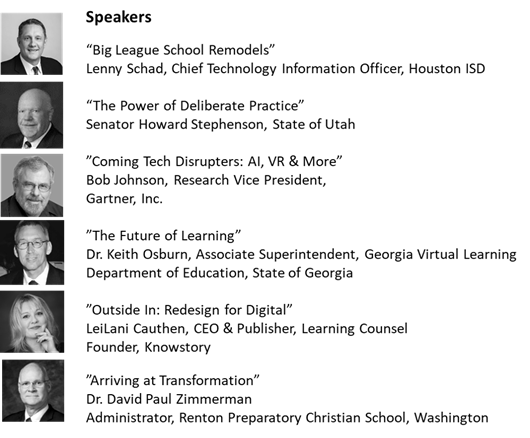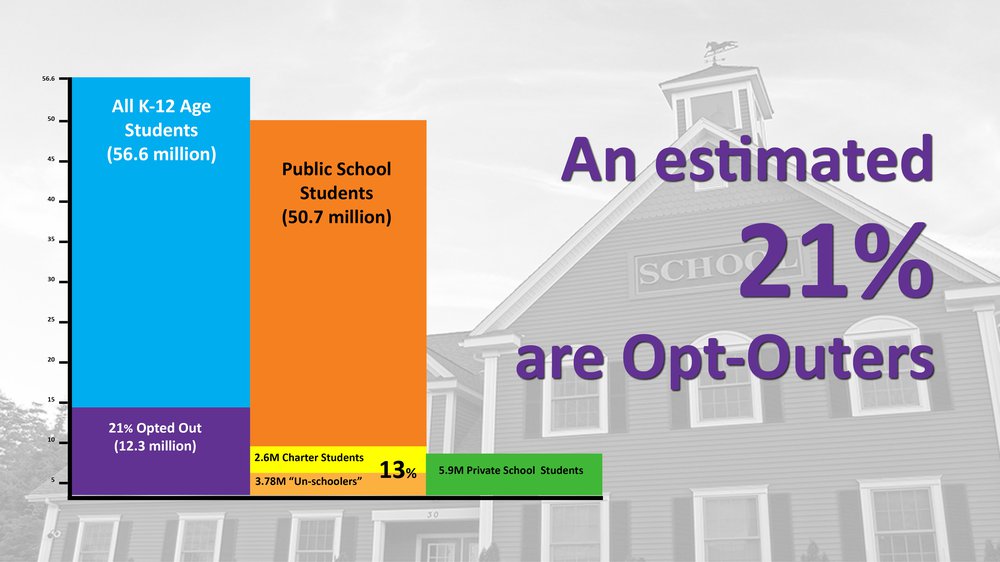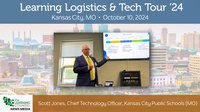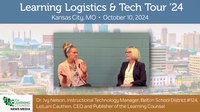I can’t shut-up about this. I know a lot of educators who live mired in their daily struggles. Many do not see what is happening to the greater system of public education with any degree of reality. They are happy with what I call “tweaking” to minorly adjust their operations for some savings, to try to drive up test scores, to get a few more enrollments, to let teachers try a few Apps, to create emotional videos of some campus event, to add a bit of technology and be “future ready” without really understanding what the future most probably will bring. They are satisfied with this sort of middle ground.
I am not. And not because I am being critical of their gains, or even of their failures. I am worried, enough that sometimes I do not sleep well. You don’t have to believe me in what I say in the rest of this article, you just have to look for yourself at the world around you beyond the walls of your schools. It’s a big America, and a disastrous-for-public-schools change has already occurred. What’s the change? It’s major tech and culture shift in a head-on collision with how education has been and still is, by and large. This has been so compelling to us at the Learning Counsel that for five years we have been bringing the truth and real training on a 30-city road trip to meet with leaders. Trust me, this has taken some stamina. I have lost three pieces of luggage, had to sleep overnight in the airport in Houston once, had innumerable delays in flights…and basically fell in love with American educators. Everywhere. They are the finest people.
Yet here are the brutal facts:
3.78 million children are being “unschooled” or “homeschooled” – 7% of the U.S. Population of K-12-Aged Children
Of the 56.6 Million K-12-aged children in the U.S., an estimated 3.78 million children are being “unschooled” or “homeschooled,” which today usually means being “counted” by a public school, but the child doesn’t physically attend or is attached to an online private school. The fact of “counting” as registered for purposes of compliance with compulsory education with public schools for the majority of these students is obscuring the real facts of the trend. They are not in the school! This is now almost 7% of the U.S. population, far exceeding the Charter School population which is just over 2.6 million children. And it’s the unlooked-for biggest movement, growing year-over-year by 8% and seeming to accelerate in 2017 with the main drivers being the fear of school shootings, bullying, disagreements with the politics of some curriculum, and a desire for a return to family. Some researchers have pointed out that the growth is closer to 25% year-over-year even while the growth of the overall population of all K-12 students is only 2%.1 Whoa, that is huge. In addition, the numbers are frequently hidden as mentioned before, due in large part to the fact that major federal studies that conduct research by “sampling” are a poor part of the story since homeschooling or unschooling is not homogenous. Parts of certain major cities, and much larger swaths of rural America are leaders in this opt-out. California is a front-runner due to its culture. State-by-state laws are also not homogenous. Some States have more private options, particularly on the East Coast. Some new charters are building massive retail-like outlets across multiple States in a “Walmart-ization” of school choice, further fracturing the picture and skewing surveys.
Homeschooling/Unschooling is Big Business
What’s interesting to me is that the homeschooling movement is also big business for companies like K12, Inc. (Fuel Education), International Connections Academy, CMASAS, Laurel Springs School, The Oaks Private School, Florida Virtual School (which is public but serves home schoolers as well), The Keystone School, and others large and small.
Consumers Spend more on Digital Learning than Schools
Are these companies profiting off a movement or creating one? Both. The smartphone industry made the internet available 24/7, and curious click-happy citizens started finding alternatives. There’s no way to stop this save shutting off the internet. The full-package online curriculum being purchased directly by American consumers amounts to $6 Billion more per year than all K-12 schools public or private put together spend today. Consumer spend also includes digital learning subscriptions, individual learning games and one-off courses – and that figure doesn’t include eTextbooks. This is the same sort of nascent reality that major retail stores faced against Amazon ten years ago. If you’ll take note, there is a massive amount of open retail real estate in almost every city today. If this trend continues with digital learning options, then education itself is up against the same disintermediation as retail. You can scoff. You can argue about how kids have to be socialized, and have to have a teacher. At the same time many of you are not going out to shop and if you had to, will most usually avoid interaction with clerks who could teach you a tremendous amount about goods available and when sales are in many instances. If you watch young students and talk to many adults, they are learning just about anything they want to know from YouTube and getting their socialization elsewhere. Also consider the direct-to-consumer options thriving in the marketplace now because there is a range of them. Mathnasium has boomed nearly overnight with 750 sites selling proven and highly personalized math accomplishment and ABCMouse has a $1 Billion market evaluation with an ever-growing consumer audience. Social Media advertising by consumer-side digital curriculum companies directed at parents and students in summer of 2018 was at all-time highs. This all indicates the trend to consumerize learning is getting stronger.
Time to be Digitally Designed
It’s at least time to say that schools should be attending to how they should be digitally designed, which is entirely different than augmenting existing learning delivery design with tacked-on technology.
Here’s some other statistics. Fewer than half of graduating students nationally are rated “proficient” in reading, math, and writing (NAEP.) America’s Education System today is ranked 36th in the world, a startling change in thirty years from being #1 – and a warning signal that systemic change is needed. The good news is that it doesn’t have to mean vouchers and charters and the same form of schooling.
Fifty-three percent of public schools think they need to spend money on repairs, renovations, and modernizations to put the school's onsite buildings in good overall condition (NCES), but today probably need an overhaul well beyond just aesthetics and creature comforts to outfit buildings with fiber networks, wireless ubiquity, and a rework of spaces to accommodate a new student workflow with digital devices. It might even be more small spaces distributed across greater geographic areas for walk-to convenience and Starbucks-like lounges with internet access.
Backward Engineer Education from Inside the Tech Reality
Yet having any digital change is being fought in many areas. It is additionally covertly fought for how deep a change will be tolerated, with the real friction at the point that transition starts to alter the job of a classroom teacher who is usually not trained in a different pedagogy. Nor are teachers being repositioned into the same critical interception points that all predominantly online systems use with customer service agents, digital chat windows, analysts, office visits and live-meetings-as-needed (a.k.a. classes). During this transition time all schools are in, too many administrators create endless process mechanisms to be ready for the future, but they do not be the future. What to be requires an understanding of the ultra-capacities of technology and the ability to backward engineer education from inside that tech reality.
The Most Missing Thing
I like to call this view of backward engineering education the “missing-est” thing in education. It is missing the most. When you do not have a view from inside the tech reality you think only with what you have experienced for yourself in the past or can see and touch right now. The things you can see now are in disassociated parts like the tablet computers, the hunks of software in random patterns, the usual sorts of staff and places. If you are not a software developer with recent knowledge of user interface, artificial intelligence, algorithm-building, animation and workflow, so it is hard to envision a seamless interweaving of education through tech into a something-else-than-has-ever-been-before.
At the Tipping Point
Understanding the data and being inside the tech reality tell me a lot about the future. Can you see what I see? The “old way” is in decay and a new way is emerging. The new way is not cleanly defined of course, which is why I travel to discuss the future with administrators everywhere. The decay is not a personal indictment, it’s not about your testing or your teachers or your buildings or which device you picked for the students. It’s about the system, and how it is meeting vastly different expectations while erroneously trying to use the same distribution and model as it has always had. That is all, but it is a deeply significant all. You see, when you combine the sheer numbers of those students who have “left the building” for alternatives in public, private or straight-up-online we are at the famous “tipping point,” an idea introduced by Malcolm Gladwell as the moment of critical mass when the mysterious sociological changes that no one really notices mark everyday life, those ideas and products and messages and behaviors, all combine into a unstoppable force that spreads like a virus to overtake the old norm.
The Shopper Mentality about Education
All together the unschoolers, private schoolers and charter students amount to 21% or greater of opt-outers due to the lag in federal data. Gladwell cites that at around 16 percent the landslide of change accelerates, and we are well past that. In 2011, Scientists at Rensselaer Polytechnic Institute found that when just 10 percent of the population holds an unshakable belief, their belief will always be adopted by the majority of the society. We stand as of 2015 at 69% of Americans giving the public school system a C or D grade in a Kappan poll. Other studies indicate that this is a general belief and that parents usually respond that their school where their child attends is okay, maybe an A or B grade. Yet the belief that the current overall system is failing is snowballing year over year. This belief shift has led to a shopper mentality about education, and the internet is rising to the challenge.
At this point, the solution to turn things around should be all-out shock-and-awe, like a Phoenix reborn from intentional ashes. I am enormously heartened, however, when there are at least significant remodels in some places of how education is being delivered.
The Inevitable Conclusion of Trends Converging
Individual educators have been making changes, such as “flipped learning” for home digital study and more interaction in the classroom, but this is not enough. Not to denigrate those valiant efforts, but to say that a new higher-level definition of flipping needs to go on at the institutional level to make a school one that is foremost a digital orchestration and secondarily a physical hub. Why? Because the advance of technologies enables long-sought freedoms, mobility and true personalization in orders of magnitude above what is currently being done. More simply, it is the inevitable conclusion of all the trends converging.
Somehow, we must get the leaders to lead for real, with a systems mentality and a primal roar in defense of public education, to become truly designed for digital.
They must gather together.
Learning Counsel is bringing together leaders we have found in our travels that we adore for their vision and drive to see personalized learning and changed conditions of delivery happen for real. Truly stunning people. Truly amazing work.
Some of the speakers include these, plus many more in a retreat-style atmosphere with plenty of networking:

Come to the Gathering. Houston, Texas, Nov. 28-30th. Ground zero for the Future.
Register today: http://learningcounselgathering.com











